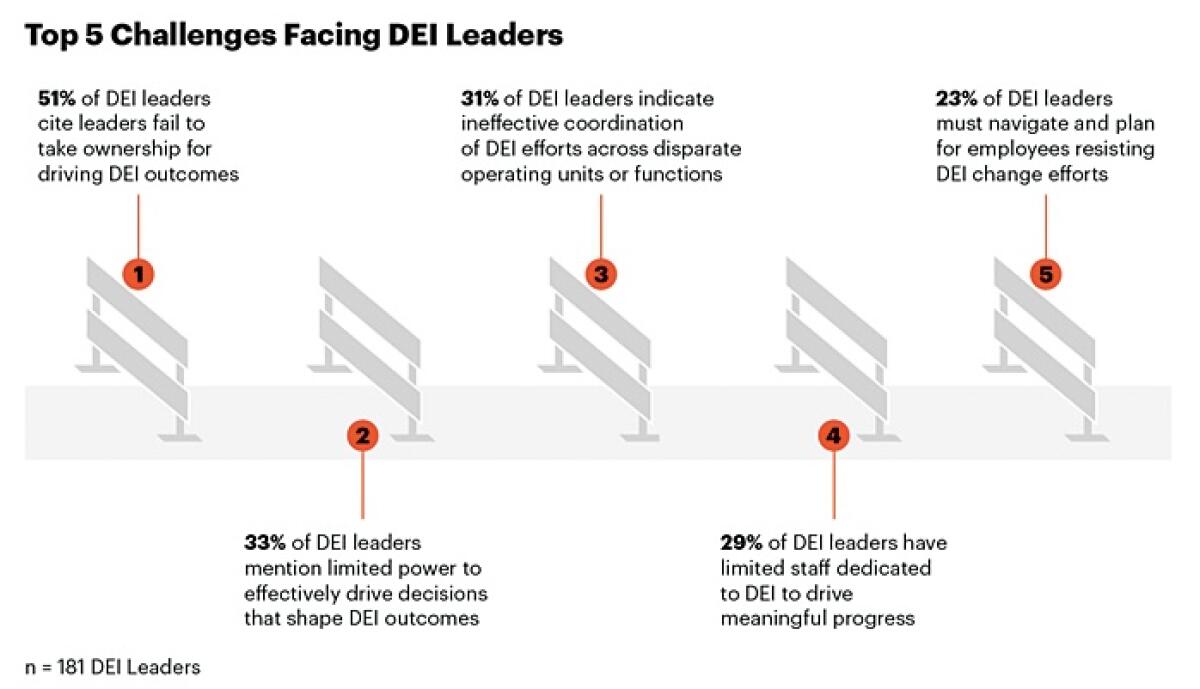The Top Five Challenges Facing DEI Leaders

Fifty-one percent of diversity equity and inclusion (DEI) leaders say their top challenge is business leaders failing to take ownership of driving DEI outcomes, according to Gartner, Inc.
A survey of 181 DEI leaders conducted last year polled DEI leaders on their proficiency, effectiveness and experiences leading the DEI function. The other top challenges that respondents ranked included: limited power to effectively drive decisions that shape DEI outcomes, ineffective coordination of DEI efforts across business units, limited DEI staff to drive progress and employee resistance to DEI change efforts.
“DEI leaders can no longer afford to take a reactive approach to DEI,” said Chandra Robinson, director in the Gartner HR practice. “As both business and labor market disruption remain the norm, DEI leaders must be proactive in uprooting workplace inequities and purposefully advocate for their function.” Gartner recommends DEI leaders adopt the following capabilities to maximize their role’s impact within their organization:
Build a Sustainable DEI Strategy
The Gartner survey revealed that 70% of DEI leaders agree senior leaders are the most critical stakeholders in an organization’s DEI strategy. Yet, many DEI leaders report having to continuously coach business leaders on why DEI matters to the organization, how it aligns with enterprise goals or why it is critical for both nearand long-term success.
To build a sustainable DEI strategy, DEI leaders must leverage key voices across the organization and gather evidence-based insights to better shape and implement their DEI strategy. This includes uncovering drivers of exclusion across diverse and underrepresented talent and anticipating unique scenarios across business functions.
Design a Scalable Governance Model
To succeed long-term, DEI efforts must be supported by a combination of policies, systems and structures - also known as a governance model - guided by key functions such as Executive Councils or Employee Resource Groups (ERGs). DEI leaders must then ensure that each governance model has a clearly defined mission and structure, including roles and responsibilities mapped to workflows and decision-makers to reduce bottlenecks in the progression of DEI efforts.
“DEI leaders are best positioned to determine opportunity areas for stakeholders that are critical for successful governance structures,” said Robinson. “Being mindful of cohesion will ultimately educate and influence others to recognize that DEI cannot progress unless organizations change how they make decisions - big or small.”
Create a Culture of Inclusion
Skilled DEI leaders aim to develop their organization’s skills, create specialized roles and build requisite programs to ensure diverse talent segments are embraced and positioned to thrive with equal access to resources. Common examples involve inclusion champion programs, inclusive leadership training and accountability partners. Gartner research shows organizations that measure DEI, create accountability and embed inclusion into talent decisions and processes report up to 20% more organizational inclusion compared to their peers without those approaches.
Establish DEI Accountability
Gartner research shows organizations that adopt consequential accountability will reach gender parity 13 years earlier and racial parity six years earlier in their leadership benches.
Specifically, consequential accountability meaningfully impacts behavior and outcomes for individual leaders. It integrates DEI measures into leaders’ performance evaluation processes to ensure that there is mutual understanding of, and commitment to, DEI as a strategic priority.
“DEI and social impact initiatives remain integral to building diverse and inclusive workplaces where employees feel safe, valued and empowered,” said Robinson. “With underrepresented talent leaving organizations at higher rates than other employee segments, organizations committed to DEI must strengthen and support their DEI leaders to set themselves apart from competitors.”